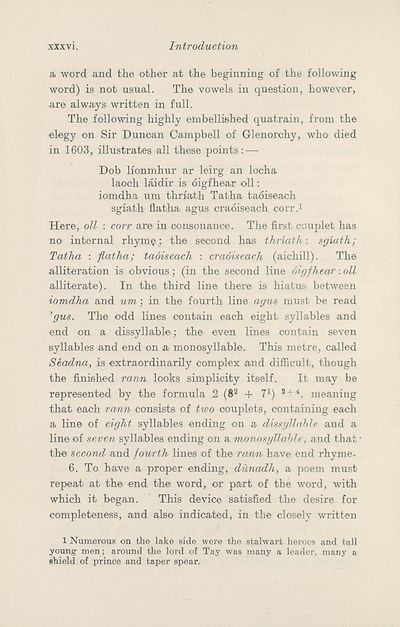Download files
Complete book:
Individual page:
Thumbnail gallery: Grid view | List view

xxx vi.
Introduction
a word and the other at the beginning of the following
word) is not usual. The vowels in question, however,
are always written in full.
The following highly embellished quatrain, from the
elegy on Sir Dunoan Campbell of Glenorchy, who died
in 1603, illustrates all these points: —
Dob Ixonmhur ar leirg an locha
laoch laidir is oigfhear oil:
iomdha um thriath Tatha taoiseach
sgiath flatha agus craoiseach corr.1
Here, oil : corr are in consonance. The first couplet has
no internal rhyme; the second has thriath-. sgiath;
Tatha : -flatha; taoiseach : craoiseach (aichill). The
alliteration is obvious; (in the second line oigfhear -. oil
alliterate). In the third line there is hiatus between
iomdha and um-, in the fourth line agus must be read
’gus. The odd lines contain each eight syllables and
end on a dissyllable; the even lines contain seven
syllables and end on a monosyllable. This metre, called
Seadna, is extraordinarily complex and difficult, though
the finished rann looks simplicity itself. It may be
represented by the formula 2 (82 + 71) a + 4, meaning
that each rann consists of two couplets, containing each
a line of eight syllables ending on a dissyllable and a
line of seven syllables ending on a monosyllable, and that ‘
the second and fourth lines of the rann have end rhyme.
6. To have a proper ending, dunadh, a poem must
repeat at the end the word, or part of the word, with
which it began. This device satisfied the desire for
completeness, and also indicated, in the closely written
1 Numerous on the lake side were the stalwart heroes and tall
young men; around the lord of Tay was many a leader, many a
shield of prince and taper spear.
Introduction
a word and the other at the beginning of the following
word) is not usual. The vowels in question, however,
are always written in full.
The following highly embellished quatrain, from the
elegy on Sir Dunoan Campbell of Glenorchy, who died
in 1603, illustrates all these points: —
Dob Ixonmhur ar leirg an locha
laoch laidir is oigfhear oil:
iomdha um thriath Tatha taoiseach
sgiath flatha agus craoiseach corr.1
Here, oil : corr are in consonance. The first couplet has
no internal rhyme; the second has thriath-. sgiath;
Tatha : -flatha; taoiseach : craoiseach (aichill). The
alliteration is obvious; (in the second line oigfhear -. oil
alliterate). In the third line there is hiatus between
iomdha and um-, in the fourth line agus must be read
’gus. The odd lines contain each eight syllables and
end on a dissyllable; the even lines contain seven
syllables and end on a monosyllable. This metre, called
Seadna, is extraordinarily complex and difficult, though
the finished rann looks simplicity itself. It may be
represented by the formula 2 (82 + 71) a + 4, meaning
that each rann consists of two couplets, containing each
a line of eight syllables ending on a dissyllable and a
line of seven syllables ending on a monosyllable, and that ‘
the second and fourth lines of the rann have end rhyme.
6. To have a proper ending, dunadh, a poem must
repeat at the end the word, or part of the word, with
which it began. This device satisfied the desire for
completeness, and also indicated, in the closely written
1 Numerous on the lake side were the stalwart heroes and tall
young men; around the lord of Tay was many a leader, many a
shield of prince and taper spear.
Set display mode to:
![]() Universal Viewer |
Universal Viewer | ![]() Mirador |
Large image | Transcription
Mirador |
Large image | Transcription
| An Comunn Gàidhealach > An Comunn Gàidhealach Publications > Bàrdachd Ghàidhlig > (40) |
|---|
| Permanent URL | https://digital.nls.uk/126455498 |
|---|
| Description | This contains items published by An Comunn, which are not specifically Mòd-related. It includes journals, annual reports and corporate documents, policy statements, educational resources and published plays and literature. It is arranged alphabetically by title. |
|---|
| Description | A collection of over 400 items published by An Comunn Gàidhealach, the organisation which promotes Gaelic language and culture and organises the Royal National Mòd. Dating from 1891 up to the present day, the collection includes journals and newspapers, annual reports, educational materials, national Mòd programmes, published Mòd literature and music. |
|---|---|
| Additional NLS resources: |
|

